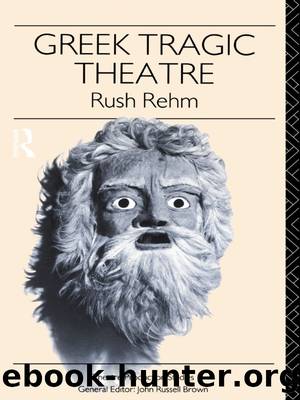Greek Tragic Theatre by Rehm Rush

Author:Rehm, Rush.
Language: eng
Format: epub
Publisher: Taylor & Francis (CAM)
Published: 2011-08-17T16:00:00+00:00
I call on my husband—
sheepdog of the flock
mainstay and mast of a warship
central pillar of a great hall
a father’s only son
land to the sailor lost at sea
calm after a night of storm
spring water to the parched traveller.
(896–901)
The hyperbole generates its gestural counterpart, as the queen orders her slaves to spread the tapestries before Agamemnon, so that ‘justice may lead him to the home/ he never hoped to see’ (911).
For a long moment the talking stops, as the servants lay out the lush red tapestries in the orchestra for Agamemnon to walk on. Do they flow out of the palace to suggest the bloodshed that lies ahead, and the past violence that has stained the house of Atreus? Or are the tapestries spread out from Agamemnon’s chariot leading up to the palace entrance, as if the blood spilt at Aulis and Troy symbolically swamps the orchestra? Or are they strewn from both ends, linking the fates of Troy and Argos, binding the past to the present? However the scene is staged, the tapestries cut the orchestra with a dark-red path, a striking visual field that draws together the various images of bloodshed in the play.
Agamemnon contemptuously rejects the oriental excess and obsequiousness of his wife’s welcome, fearing that by trampling such wealth he might inspire envy from the gods. Now Clytemnestra raises the dramatic stakes, initiating a rapid stichomythic exchange with her husband, and after a dialogue of only fourteen lines, Agamemnon yields to her request. Critics have tried to glean the rational basis for his change of heart, but in performance the crucial shift is less a question of argument and deliberation than of rhythm—Agamemnon is swept up by Clytemnestra’s verbal pace and energy. Put in psychological terms, tragic stichomythia respects the mystery of decision without attempting to explain it away, acknowledging that men and women often pretend to rational choice while really making a stab in the dark.
Before stepping down from the chariot, Agamemnon introduces Cassandra and orders his wife to welcome her as a new slave into the house. But Cassandra quickly is forgotten once Agamemnon tramples down the dark-red path. His conduct is not sacrilegious (the cloth is not sacred); rather it symbolizes Agamemnon’s destruction of the wealth of the house. Clytemnestra enforces that sense as she coaxes her husband inside, vowing to drain the sea for the dyes needed to colour miles of such fabric, willing ‘to lay out all the bounty of the house to be trampled,/…/weaving the strands that bring this life home’ (963–65). Her verbal excess matches the boldness of the action, and when her husband reaches the palace, she utters a final prayer that seems to signal his imminent death: ‘Zeus, Zeus, harvester! Ripen my prayers./Turn your mind to the harvest at hand’ (973–74). She follows Agamemnon inside, the carpets are removed, and the chorus are left to consider what has happened, and what lies ahead.
In a quick-paced, agitated ode, they admit that the king has returned safely, but they cannot silence their premonitions, a ‘dirge of the Furies’ that sings within (900–02).
Download
This site does not store any files on its server. We only index and link to content provided by other sites. Please contact the content providers to delete copyright contents if any and email us, we'll remove relevant links or contents immediately.
| Ancient & Classical | Anthologies |
| British & Irish | Children's |
| Comedy | LGBT |
| Medieval | Regional & Cultural |
| Religious & Liturgical | Shakespeare |
| Tragedy | United States |
| Women Authors |
Cecilia; Or, Memoirs of an Heiress — Volume 2 by Fanny Burney(31909)
Cecilia; Or, Memoirs of an Heiress — Volume 3 by Fanny Burney(31888)
Dialogue by Robert McKee(4353)
The 101 Dalmatians by Dodie Smith(3481)
Bound by Hatred (The Singham Bloodlines Book 2) by MV Kasi(3043)
The Art of Dramatic Writing: Its Basis in the Creative Interpretation of Human Motives by Egri Lajos(3036)
Harry Potter and the Cursed Child - Parts One and Two by John Tiffany(3015)
The Beautiful Boys: A High School NA Reverse Harem Paranormal Bully Romance (Shadowlight Academy Book 1) by Gow Kailin(2842)
Angels in America by Tony Kushner(2623)
Carrie's War by Nina Bawden(2443)
A Clockwork Orange by Anthony Burgess(2437)
Unlaced by Jaci Burton & Jasmine Haynes & Joey W. Hill & Denise Rossetti(2346)
The Femme Playlist & I Cannot Lie to the Stars That Made Me by Catherine Hernandez(2268)
Open Book by Jessica Simpson(2234)
Drama by John Lithgow(2211)
Outside Woman (BWWM Amish Romance) by Stacy-Deanne(2097)
Terrorist Cop by Mordecai Dzikansky & ROBERT SLATER(2051)
Yerma by Federico García Lorca(2041)
Leo's Desire by Sundari Venkatraman(1909)
